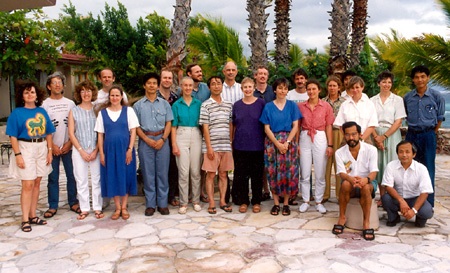The Great Apes Revisited
Date
Nov 12 - Feb 19, 1994Organized by
William C. McGrew and Toshisada NishidaLocation
Hotel Cabo San Lucas, Baja California Sur, MexicoPublications
Great Ape Societies (William C. McGrew, Linda F. Marchant and Toshisada Nishida, Eds.) Cambridge University Press, New York, 1996.Participants
- Christophe Boesch University of Basel, Switzerland
- Frans B.M. de Waal Emory University, USA
- Diane M. Doran State University of New York, Stony Brook, USA
- Barbara Fruth Max-Planck-Gesellschaft, Germany
- Jane Goodall Jane Goodall Institute, USA
- Charlotte K. Hemelrijk University of Zürich, Switzerland
- Takayoshi Kano Kyoto University, Japan
- Suehisa Kuroda Kyoto University, Japan
- Linda F. Marchant Miami University of Ohio, USA
- Tetsuro Matsuzawa Kyoto University, Japan
- William C. McGrew Miami University of Ohio, USA
- John Mitani University of Michigan, USA
- James Moore University of California-San Diego, La Jolla, USA
- Toshisada Nishida Kyoto University, Japan
- Sue Savage-Rumbaugh Georgia State University, USA
- Sydel Silverman Wenner-Gren Foundation, USA
- Caroline Tutin University of Stirling, UK
- Carel van Schaik Duke University, USA
- David P. Watts University of Michigan, USA
- Frances J. White Duke University, USA
- Richard Wrangham Kibale Chimpanzee Project, Uganda
- Juichi Yamagiwa Kyoto University, Japan
- Adrienne Zihlman University of California, Santa Cruz, USA
ORGANIZER’S STATEMENT: Commemorating the twentieth anniversary of another Wenner-Gren conference – the landmark symposium “The Behavior of Great Apes” – this symposium sought to continue the collaborative spirit of the previous meeting by bringing together twenty-one primatologists from the United States, Europe, and Japan to review, discuss and extend current knowledge of humankind’s nearest living relation, the Great Apes (Pongidae). The focus was on apes in nature (particularly, the forests, woodlands, and savannas of sub-Saharan Africa and the Malay archipelago) but researchers on apes in captivity were present, too, and both social and natural scientific viewpoints were espoused. Emphasis on behavioral diversity – whether across individuals, groups, populations, or species yielded solid results in clarifying appreciation of what is constant about great apes, regardless of habitat, and what is not. Differing viewpoints concerning methodology and theory were discussed, and contacts were made which should yield valuable collaborative opportunities. Papers presented at the conference are to appear in an edited volume (Great Ape Societies, Cambridge University Press), which is scheduled for publication in August 1996.
Wenner-Gren Symposium #118
